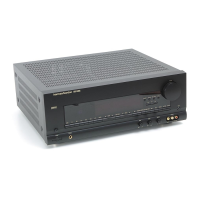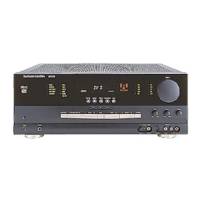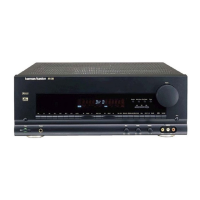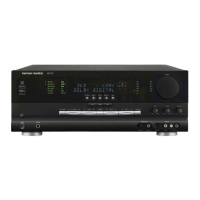Operation
4. The current time as transmitted by the
station. It may take up to two minutes for
the time to appear.
5. After cycling through the RDS data
information the next press of the Display
button is OFF. If the button is not pressed
again in 3 seconds, the display will turn
off. Press Display one more time or any
other button to return to the main RDS
information display or to turn the display
back on.
• Some RDS stations may not choose to
include some of these additional features.
If the data required for the selected mode
is not being transmitted, the display will
show a NONE (no PTY), NOTEXT or
NOTIME message each time the
Display button
¸ k
is pressed.
• In any FM mode the RDS function
requires a strong enough signal for proper
operation. If you see wrong characters in
the station name, changing from time to
time, or the messages NOTEXT or NO
TIME switching on and off, try slowly
adjusting the antenna to improve the
signal strength or tune to another,
stronger, RDS station.
• If a station is not transmitting RDS, or
if the signal is weak, the display will show
NO RDS right befor the other "NO"
messages mentioned above, if Display
¸ k
is pressed.
Tape Recording
In normal operation, the audio or video
source selected for listening through the
AVR41 is sent to the record outputs. This
means that any program you are
watching or listening to may be recorded
simply by placing machines connected to
the outputs for Tape 1 §, Tape 2 ¢
or Video 1 ª in the record mode.
When a tape recorder with separate
record and playback heads (3 head deck)
is connected to the Tape 1 Mon in/
outputs ∞§, you may monitor the
output of the recording by selecting the
Tape 1/Monitor input
8d
. Note
that the word MONITOR will briefly
appear in the front panel display to
remind you that you are listening to the
record playback instead of the actual
input source being recorded. After three
seconds the display will once again
display the selected input source, but the
red TAPE M indicator will remain
illuminated to remind you that you are
listening to the record playback rather
than the direct input source.
When a video recording is made and
audio source is selected, the last video
source used remains routed to the
Monitor and Video 1 outputs ª‚.
This permits simultanous viewing,
listening and recording of different A/V
sources
Video Dubbing
Special circuits in the AVR41 make it
possible to copy the programme from
one video source to another while you
are viewing/listening to a separate and
different input. When making a video
dub note that the VCR connected to
Video 1 ª will always be the record
machine, and the playback source will be
either the equipment connected to the
Video 2 input ¶ or the front panel
Video 3
%
.
To make a video copy, simply press the
front panel Video Dubbing button
3536
corresponding to the video source
being played back. It is not necessary to
press the Input Selection buttons when
making a direct video dub. The
information display will briefly show
VID2 > 1 or VID3 > 1 to confirm
the dubbing operation. After the display
returns to show the current input source
for the main system, a red indicator will
illuminate inside the Video Dubbing
button to remind you that a Video Dub is
in process. To turn the video dubbing off,
simply press the same Video Dubbing
button again.
20
ENGLISH
32642_AVR41 Eng 04/03/1998 9:03 Side 20

